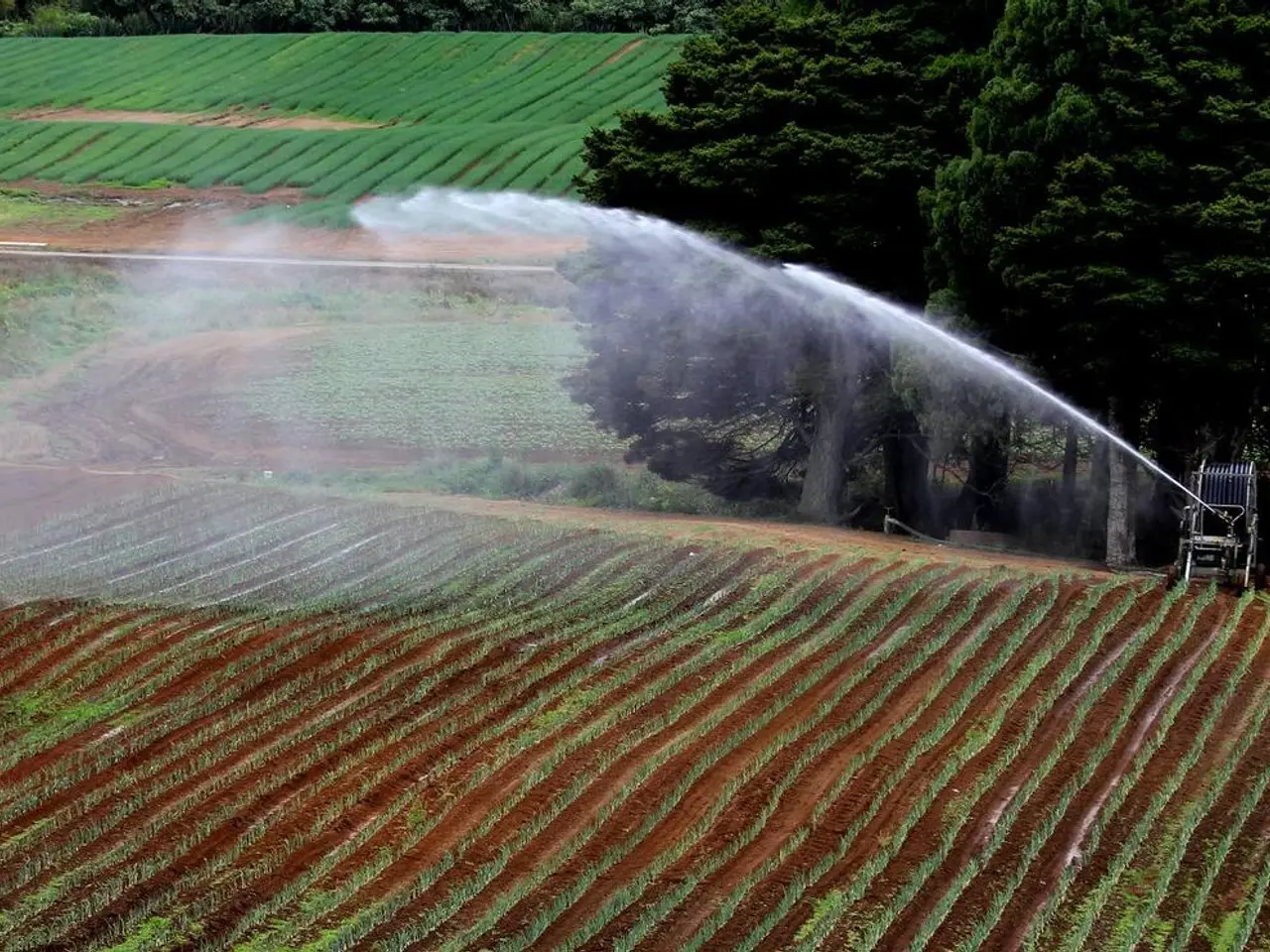Strengthening Agricultural Resilience through Solar Energy – Bolstering Food Security
In a world grappling with climate change, water scarcity, soil degradation, and energy dependency, solar energy is emerging as a beacon of hope for farmers and the global food system. This renewable source of power not only offers a clean and sustainable energy solution but also enhances agricultural resilience and contributes significantly to food security.
Solar energy is transforming agricultural practices in various ways. One such transformation is through Agrivoltaics and Prairie-Voltaics, where solar panels are co-located with agriculture. This innovative approach creates beneficial microclimates, reducing plant heat stress and retaining soil moisture, thereby improving crop yields and water-use efficiency. A study found that cherry tomato yields doubled under solar panels with 65% higher water-use efficiency compared to open-sun cultivation [1].
Another significant advancement is the adoption of solar-powered irrigation systems. These systems use solar panels to power irrigation pumps, improving water management and reducing energy costs for farmers. This enhancement not only ensures consistent water supply but also helps farmers adapt to climate change by reducing their vulnerability to fluctuating energy prices [2].
Solar Grazing is another model that supports renewable energy while maintaining agricultural land in production. This approach reduces the need for gas-powered equipment, lowers carbon emissions, and enhances ecosystem health by promoting native plant growth and pollinator habitats [3].
Solar energy is providing a lifeline for farmers, reducing their financial burden by lowering energy costs associated with irrigation and other farm operations. This financial relief enables farmers to invest more in food production, contributing to global food security [2].
Moreover, solar energy is helping farmers adopt more sustainable methods, improving soil health and preserving natural resources essential for long-term food production [3][4]. Solar-powered systems help farmers adapt to climate change by ensuring reliable access to water and maintaining soil health, critical for maintaining crop yields in challenging environmental conditions [2][4].
Furthermore, farmers can generate additional income by selling excess solar energy, further stabilizing their financial situation and enhancing their capacity to produce food [2]. In regions like Kenya and Nigeria, solar-powered cold storage units are helping preserve perishable goods, reducing post-harvest losses and increasing farmers' incomes [6].
Solar dryers can efficiently process crops without relying on fossil fuels, reducing environmental impact and improving product quality [7]. In India, the adoption of solar-powered irrigation systems has transformed farming practices in remote and off-grid areas [8].
In the Netherlands, solar greenhouses have photovoltaic panels integrated into their structure, generating electricity while allowing sufficient sunlight for plant growth [5]. This innovative approach enables farmers to produce high-value crops year-round, reducing reliance on fossil fuels and enhancing agricultural productivity.
The benefits of solar energy extend beyond the farm. In rural areas, improved living standards are being achieved through the provision of reliable electricity for lighting, cooking, and other domestic needs, reducing reliance on polluting fuels [9].
However, it's crucial to note that smallholder farmers, who are particularly vulnerable to climate change due to limited resources and infrastructure, need targeted support to adapt to these new technologies [10].
In conclusion, solar energy is a powerful tool in the fight against climate change and for enhancing global food security. By harnessing its potential, we can create a more resilient, sustainable, and equitable food system.
References: [1] https://www.nature.com/articles/s41586-020-2682-y [2] https://www.sciencedirect.com/science/article/pii/S2214629617303357 [3] https://www.sciencedirect.com/science/article/pii/S030147971930399X [4] https://www.mdpi.com/2071-1050/12/10/3128 [5] https://www.researchgate.net/publication/323055705_Solar_greenhouses [6] https://www.sciencedirect.com/science/article/pii/S0306261917313713 [7] https://www.mdpi.com/2071-1050/12/14/3765 [8] https://www.sciencedirect.com/science/article/pii/S2214629617303357 [9] https://www.sciencedirect.com/science/article/pii/S030147971930399X [10] https://www.fao.org/3/ca8627en/ca8627en.pdf
- Solar power is a renewable energy source that offers a clean and sustainable solution for the global food system, reducing dependencies on fossil fuels.
- Solar panels, when combined with agriculture in Agrivoltaics and Prairie-Voltaics, create beneficial microclimates that improve crop yields and water-use efficiency.
- The Agrivoltaic and Prairie-Voltaic approach not only reduces plant heat stress but also retains soil moisture, contributing to sustainable practices in the agricultural industry.
- Solar-powered irrigation systems use solar panels to power irrigation pumps, improving water management and reducing energy costs for farmers.
- Solar Grazing, another model, supports renewable energy while maintaining agricultural land in production, reducing carbon emissions and promoting native plant growth.
- Solar energy provides financial relief to farmers by lowering energy costs associated with irrigation and farm operations, enabling investment in food production.
- By adopting solar energy, farmers can adopt more sustainable methods, improving soil health and preserving natural resources for long-term food production.
- Solar-powered systems help farmers adapt to climate change by ensuring reliable access to water and maintaining soil health, critical for sustaining crop yields.
- Farmers can generate additional income by selling excess solar energy, further enhancing their financial stability and production capacity.
- In some regions like Kenya and Nigeria, solar-powered cold storage units help preserve perishable goods, reducing post-harvest losses and increasing farmers' incomes.
- Solar dryers can efficiently process crops without relying on fossil fuels, improving product quality and reducing environmental impact.
- The adoption of solar-powered irrigation systems in India has transformed farming practices in remote and off-grid areas.
- In the Netherlands, solar greenhouses employ photovoltaic panels, generating electricity while allowed sufficient sunlight for plant growth.
- Solar greenhouses enable farmers to produce high-value crops year-round, reducing reliance on fossil fuels and enhancing agricultural productivity.
- In rural areas, improved living conditions are being achieved through reliable electricity for basic needs like lighting and cooking, reducing pollution.
- Smallholder farmers require targeted support to adapt to new solar technologies due to their vulnerability to climate change.
- To achieve a more resilient, sustainable, and equitable food system, it's necessary to harness the potential of solar energy.
- The benefits of solar energy extend beyond the farm, affecting various aspects of the environment, technology, and business, including food-and-drink lifestyle, housing-market, global-cuisines, real-estate, data-and-cloud-computing, and career development.
- Successful deployment of solar power can contribute to energy independence and personal growth, fueling global progress in environmental-science, science, education-and-self-development, learning, and skills-training.
- The integration of solar power in more industries such as sports (for example, LED lights in football stadiums during Champions League matches or European leagues playoffs) can further reduce carbon footprints and promote sustainable practices.







